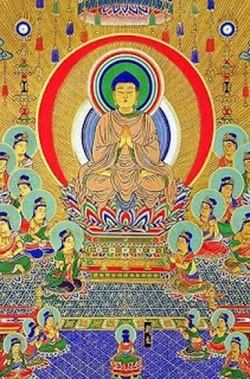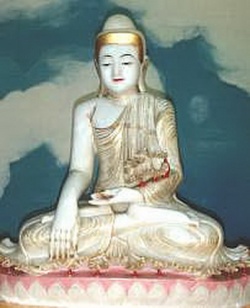The Buddhist's Gateway to China
<poem> Buddhist masters from India and central Asia, passing through Dunhuang on their way to Chang'an, capital of China, would stop to meditate in the famous painted caves or consult manuscripts in the monastery's library. Dunhuang served as the ideal place for monks to learn Chinese language and culture before entering central China.
Starting in the late third century, Buddhist temples, gardens, pagodas and lecture halls were built to accomadate the growing and vibrant monastic communities.
Elaborate devotional ceremonies attracted Buddhist monks and worshippers from all over inner Asia. In the annual June festival, silk banners bearing Buddha images and sacred writings were hung from the cliff face and the fragrance of incense burning in the caves hung heavy in the air. (Whitfield, Cave Temples 22)
Regional dignitaries and government officials, important monks, wealthy merchants and associations of local people sponsored the construction of new caves. From 571 to 966 construction of the major caves and statues was almost continuous, including several giant statues of the Buddha.
Buddhism becomes Chinese Perhaps most significant to the overall history of Buddhism, Dunhuang was home to a major translation center through which Buddhist texts from India and central Asia were put into Chinese language, copied and transmitted throughout China, even before the cave temples were begun.
One of the most important early translator-monks of early Buddhism established his school at the Dunhuang monasteries. Dharmaraksha (266 – 308 CE) was born in China to parents from central Asia. He studied in a monastery under an Indian teacher and traveled throughout central Asia. As a result he learned Indian as well as several central Asian languages. He made the first Chinese translations of key Buddhist texts such as The Lotus Sutra and The Large Perfection of Wisdom.
Under Dharmaraksha's leadership, his disciples made a critical mass of Buddhist texts available to Chinese readers. With these translations available throughout China, Buddhism began to gain converts from all levels of Chinese society. His disciples went into China itself on missions, established monasteries and generally furthered the spread of Buddhism in China. (Robinson 105)
Printing speeds the spread of Buddhism Dunhuang monasteries continued Dharmaraksha's work of translating and disseminating Buddhist texts throughout their existence. These efforts The Diamond Sutra became even more speedy with the invention of printing. The earliest printed pages in the world have been found in the Dunhuang caves, preserved by the dry desert climate. These Buddhist pictures, short prayers and texts date from approximately 765 CE. The world's oldest printed book, The Diamond Sutra, was also produced at Dunhuang in 868 CE.
The production of printed works corresponds to the height of Buddhism's presence in China. In 751 a Chinese army was defeated in central Asia by Muslims, opening west China to the gradual influx of Islam. In 842-845 CE the Tang emperors of China issued a great proscription against Buddhist monasteries and monks, destroying 4600 monasteries and temples, sending more than 250,000 monks back to their homes and seizing much of the enormous wealth that had been accumalated by the Buddhist monasteries. Although Dunhuang was not particularly hard hit by these government measures, Chinese Buddhism itself never fully recovered. As a result, devotion and donation to the Dunhuang caves gradually declined; the last major cave building occuring in the late 900's. <poem>

